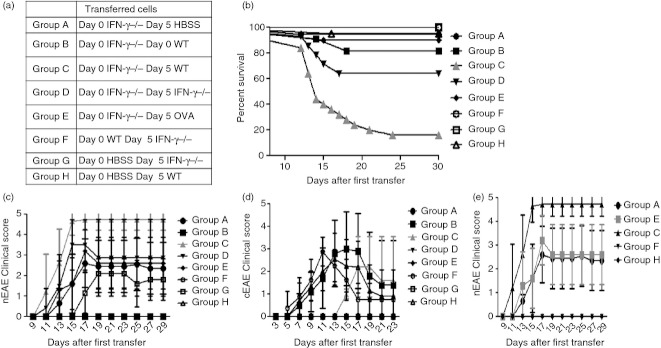Figure 1.

Addition of freshly activated encephalitogenic interferon‐γ (IFN‐γ) ‐sufficient cells shortly after induction of non‐classical experimental autoimmune encephalomyelitis (EAE) exacerbates disease. Mice received 5 × 106 IFN‐γ‐deficient MOG35–55‐specific CD4+ T cells (Groups A, C, D, E), 5 × 106 IFN‐γ‐sufficient MOG35–55‐specific CD4+ T cells (Group F), or Hanks’ balanced salt solution (HBSS) (Groups G, H) (where MOG35–55 is a peptide comprising amino acids 35 to 55 of the myelin oligodendrocyte glycoprotein). In addition, one group (Group B) received both 5 × 106 wild‐type and 5 × 106 IFN‐γ‐deficient MOG35–55‐specific CD4+ T cells concurrently. Five days later mice received 5 × 106 wild‐type MOG35–55‐specific CD4+ T cells (Groups C, H), 5 × 106 wild‐type ovalbumin‐specific CD4+ T cells (Group E), 5 × 106 IFN‐γ‐deficient MOG35–55‐specific CD4+ T cells (Groups D, F, G), or an equivalent amount of HBSS (Group A). Group composition is summarized in (a). Mouse survival was then followed over time (b). Mice were examined for the development of both non‐classical (c) and classical (d) EAE symptoms. Results shown were collected from two separate experiments using five mice in each group.
